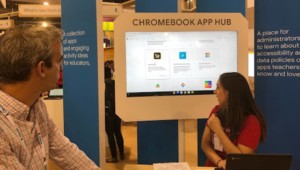4 Reasons For The Rise of Chromebooks

Google’s Chromebook laptops have become more popular in the classroom than Apple’s iPad. IDC reported third quarter Chromebook sales of 715,000 versus Apple’s 702,000 iPads.
There are four reasons that 2014 was the year of the Chromebook. First is that they are really cheap. The web appliances have most of the features of a laptop but without expensive memory of laptops. You can buy a Chromebook for as little as $199. Even an entry-level iPad with an education discount can cost between $300 and $400.
The second reason for the emergence of the Chromebook is easy management. With the Chrome management console, admins can easily control users, devices and apps across a fleet of Chromebooks.
The third reason for the rise of Chromebooks is Google Apps for Education, free cloud-based email, storage, collaborative documents and presentations, all in a cloud-based system. Districts like Kettle Moraine, “Have quickly learned how these tools can open doors to new collective, instructional and organizational opportunities.” Teachers share Docs, Forms, and Presentations. Teachers in the small Milwaukee area district benefit from seven certified Google trainers.
The fourth reason Chromebooks have become popular is that they have the instant on function and battery life of a tablet with nearly all of the functionality of a laptop.
For all these reasons, NYC DOE added Chromebooks to the list of approved devices in November.
The rap on Chromebooks was limited offline functionality but that has improved.
“They are a solid piece of technology at a very reasonable price,” said Erin Mote, co-founder of Brooklyn Lab. She noted, “Some limited challenges with plugins from educational software and they need a strong network infrastructure to support a 1:1 deployment.” For budgeting, Mote suggested a loss/damage rate of 25%, “The exterior case breaks and cracks easily, we have had some challenges with the battery in a limited number.”
Chromebooks are made by folks like Samsung, Acer, and HP (collectively they account for about 75%), so Google isn’t making money on hardware. Because they’re giving away apps, they’re not making much from the edu vertical but they are building a really big user base.
Rich video, game-based and adaptive content initiated in the last five or 10 years often used Flash and didn’t run on iPad–giving Chromebooks a distinct advantage for schools that want to anchor a blended learning program with an adaptive learning. However, that’s starting to change. Mind Research Institute, rewrote more than 900 games ST Math to for iPads. In November, Dreambox Learning released an iPad version of its popular adaptive math program.
Microsoft is doing its part to give the Chromebook some tough competition. New products such as the HP Stream costs about the same as a Chromebook, run Windows and include a free one-year subscription to Office 365 Personal. For a little perspective, total Chromebook sales in 2014 where about 4 million while 300 million Windows machines were sold. And Windows OS devices held a 68% share while Chrome OW was about 5%.
The good news is that with $200 student access devices, it is affordable for every school to provide a device for every student. With all the free apps and open resources available, it is less expensive to go digital than to buy a stack of textbooks. While teaching and parenting matter more than ever, the advance in 1:1 connectivity is helping to narrows the digital divide and expand learning opportunity.
- Google Apps Summer Camp: Chromebooks
- 7 Trends That Shaped 2014; 7 Problems We’ll Solve in 2015
- Why Three Districts Chose Chomebooks Over Tablets
Dreambox Learning and MIND Research Institute are Getting Smart Advocacy Partners.





Theo
I don't know if I totally agree with this.. First off if the states didn't have common core state mandated online testing Chromebooks would be at least half of what it is. Like NJ/NY taking the PARCC state testing is almost forcing schools to go 1 to 1 and the cheapest and somewhat reliable way to go is a Chromebook. So I would rate state testing #1 - with the chief tech officer coming from Google and the states pushing 1 to 1 for online testing. #2 price #3 might be ease of apps/extension deployment #4 unit deployment with a low cost white glove service vendors are offering that really the Tech Departments are not even touching the devices they rather spend the money
Bill
Here is a list of PARCC states:
http://www.parcconline.org/parcc-states
Here is the other testing - http://www.smarterbalanced.org/about/
And magically the Nation's Chief Technology Officer is coming from Google.. Who's in who's pocket now
Replies
Tom Vander Ark
Logic seems tortured at best Bill
Don Crawford
You're right about Chrome Books gaining on tablets. I've been hearing from potential customers who want my Apple app, Rocket Math, http://www.rocketmath.com/p/app.html made available for Chromebooks and web-based app. My app is uniquely designed so that it actually builds mastery of math facts rather than just engaging kids in playing a game but not learning something new. (I am working to collect data to prove that.) However, at 1.99 per customer it's going to take a long time to earn the $20,000 to $30,000 needed to pay for re-development on a new platform. And I heard you promoting free apps, as the wave of the future. Who is willing to invest in the development costs of something that is going to be distributed for free? Are schools adopting apps that include advertising? Can you direct me to somewhere to go to learn about how to find funding and develop business plans for creating powerful and effective instructional apps in a world of free and nearly free educational apps? As a instructional designer who understands mastery, I have ideas for game-like instruction in many areas but relying on self-funding of my passion is holding me back. Thanks for any help you can direct me towards.
Replies
Tom Vander Ark
Hi Don,
Free apps with premium features is an exciting but largely unproven business model in edu. Last weekend, the NYTimes took up this question with a pretty good post: http://www.nytimes.com/2015/01/12/technology/silicon-valley-turns-its-eye-to-education.html
In a summer post Fred Wilson (a co-investor in Edmodo) explains how DuoLingo will monetize assessment
http://avc.com/2014/07/freemium-in-education/
Freemium isn't easy to pull off--you need a compelling app and the runway (and investors) to build and monetize network effects.
The alternative of selling mobile apps to parents or schools can be a faster and cheaper path to breakeven but it is equally challenging.
Kurt
I agree with the first three completely; however, I have issues with the fourth and with this statement, "with nearly all of the functionality of a laptop." I know you used "nearly" to partly address this issue. For those who only use computers for word processing and other office applications, that might be true; however, there is so much more that a computer can do that a netbook can't. Also, I love using Google apps and use them all the time; however for those who are extensive users of MS Excel, for example, Sheets isn't quite there yet. How many of us in our professional jobs could just use a Chromebook for all of our work? Do you? Do you have data on professional use of Chromebooks as the main work device? Will a Chromebook be enough for students once they enter their chosen professions? If money wasn't an issue, would it be better for students to have a full computer that can do all a netbook can but more? So many questions; however, most people just look at your first and third points and jump.